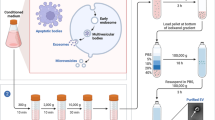Abstract
Bone has the capacity to regenerate and repair itself. However, this capacity may be impaired or lost depending on the size of the defect or the presence of certain disease states. In this review, we discuss the key principles underlying bone healing, efforts to characterize bone stem and progenitor cell populations, and the current status of translational and clinical studies in cell-based bone tissue engineering. Though barriers to clinical implementation still exist, the application of stem and progenitor cell populations to bone engineering strategies has the potential to profoundly impact regenerative medicine.
Similar content being viewed by others
References
Galen (1997). The usefulness of parts of the body. Clinical Orthopaedics and Related Research, 337, 3–12.
Howship, J. (1816). Microscopic observations on the structure of bone. Medico-chirurgical transactions, 7(382–592), 311.
Zhang, J., et al. (2003). Identification of the haematopoietic stem cell niche and control of the niche size. Nature, 425(6960), 836–841.
Calvi, L. M., et al. (2003). Osteoblastic cells regulate the haematopoietic stem cell niche. Nature, 425(6960), 841–846.
Ding, L., & Morrison, S. J. (2013). Haematopoietic stem cells and early lymphoid progenitors occupy distinct bone marrow niches. Nature, 495(7440), 231–235.
Zhou, B. O., Yue, R., Murphy, M. M., Peyer, J. G., & Morrison, S. J. (2014). Leptin-receptor-expressing mesenchymal stromal cells represent the main source of bone formed by adult bone marrow. Cell Stem Cell, 15(2), 154–168.
Cheloha, R. W., Gellman, S. H., Vilardaga, J. P., & Gardella, T. J. (2015). PTH receptor-1 signalling-mechanistic insights and therapeutic prospects. Nature reviews. Endocrinology, 11(12), 712–724.
Rinkevich, Y., Lindau, P., Ueno, H., Longaker, M. T., & Weissman, I. L. (2011). Germ-layer and lineage-restricted stem/progenitors regenerate the mouse digit tip. Nature, 476(7361), 409–413.
Chan, C. K., et al. (2015). Identification and specification of the mouse skeletal stem cell. Cell, 160(1–2), 285–298.
Worthley, D. L., et al. (2015). Gremlin 1 identifies a skeletal stem cell with bone, cartilage, and reticular stromal potential. Cell, 160(1–2), 269–284.
Marecic, O., et al. (2015). Identification and characterization of an injury-induced skeletal progenitor. Proceedings of the National Academy of Sciences of the United States of America, 112(32), 9920–9925.
Rho, J. Y., Kuhn-Spearing, L., & Zioupos, P. (1998). Mechanical properties and the hierarchical structure of bone. Medical Engineering & Physics, 20(2), 92–102.
Wang, Y., et al. (2012). The predominant role of collagen in the nucleation, growth, structure and orientation of bone apatite. Nature Materials, 11(8), 724–733.
Olsen, B. R., Reginato, A. M., & Wang, W. (2000). Bone development. Annual Review of Cell and Developmental Biology, 16, 191–220.
Nah, H. D., Pacifici, M., Gerstenfeld, L. C., Adams, S. L., & Kirsch, T. (2000). Transient chondrogenic phase in the intramembranous pathway during normal skeletal development. Journal of Bone and Mineral Research: the Official Journal of the American Society for Bone and Mineral Research, 15(3), 522–533.
Dimitriou, R., Tsiridis, E., & Giannoudis, P. V. (2005). Current concepts of molecular aspects of bone healing. Injury, 36(12), 1392–1404.
Einhorn TA (1998) The cell and molecular biology of fracture healing. Clinical orthopaedics and related research (355 Suppl):S7–21.
Tsiridis, E., Upadhyay, N., & Giannoudis, P. (2007). Molecular aspects of fracture healing: which are the important molecules? Injury, 38(Suppl 1), S11–S25.
Phillips, A. M. (2005). Overview of the fracture healing cascade. Injury, 36(Suppl 3), S5–S7.
Schindeler, A., McDonald, M. M., Bokko, P., & Little, D. G. (2008). Bone remodeling during fracture repair: the cellular picture. Seminars in Cell & Developmental Biology, 19(5), 459–466.
Salgado, A. J., Coutinho, O. P., & Reis, R. L. (2004). Bone tissue engineering: state of the art and future trends. Macromolecular Bioscience, 4(8), 743–765.
Kraus, K. H., & Kirker-Head, C. (2006). Mesenchymal stem cells and bone regeneration. Veterinary surgery: VS, 35(3), 232–242.
Sacak B, et al. (2016) Repair of critical size defects using bioactive glass seeded with adipose-derived mesenchymal stem cells. Journal of biomedical materials research. Part B, Applied biomaterials. doi:10.1002/jbm.b.33632
Hendrikx, S., et al. (2016). Indirect rapid prototyping of sol-gel hybrid glass scaffolds for bone regeneration - effects of organic crosslinker valence, content and molecular weight on mechanical properties. Acta Biomaterialia, 35, 318–329.
Ren, Z., et al. (2015). Effective bone regeneration using Thermosensitive poly(N-Isopropylacrylamide) grafted gelatin as injectable carrier for bone mesenchymal stem cells. ACS Applied Materials & Interfaces, 7(34), 19006–19015.
Han LH, et al. (2016) Microribbon-based hydrogels accelerate stem cell-based bone regeneration in a mouse critical-size cranial defect model. Journal of biomedical materials research. Part A, 104(6), 1321–1331.
Levi, B., et al. (2010). Human adipose derived stromal cells heal critical size mouse calvarial defects. PloS One, 5(6), e11177.
Park, J. S., & Park, K. H. (2016). Light enhanced bone regeneration in an athymic nude mouse implanted with mesenchymal stem cells embedded in PLGA microspheres. Biomaterials research, 20, 4.
Nagasaki, R., et al. (2015). A combination of low-intensity pulsed ultrasound and nanohydroxyapatite concordantly enhances osteogenesis of adipose-derived stem cells from Buccal fat pad. Cell medicine, 7(3), 123–131.
Dufrane, D., et al. (2015). Scaffold-free three-dimensional graft from autologous adipose-derived stem cells for large bone defect reconstruction: clinical proof of concept. Medicine, 94(50), e2220.
Rodriguez-Collazo, E. R., & Urso, M. L. (2015). Combined use of the Ilizarov method, concentrated bone marrow aspirate (cBMA), and platelet-rich plasma (PRP) to expedite healing of bimalleolar fractures. Strategies in trauma and limb reconstruction, 10(3), 161–166.
Ajiboye, R. M., Hamamoto, J. T., Eckardt, M. A., & Wang, J. C. (2015). Clinical and radiographic outcomes of concentrated bone marrow aspirate with allograft and demineralized bone matrix for posterolateral and interbody lumbar fusion in elderly patients. European spine journal: official publication of the European Spine Society, the European Spinal Deformity Society, and the European Section of the Cervical Spine Research Society, 24(11), 2567–2572.
Author information
Authors and Affiliations
Corresponding author
Ethics declarations
Disclosures
The authors indicate no potential conflicts of interest.
Rights and permissions
About this article
Cite this article
Walmsley, G.G., Ransom, R.C., Zielins, E.R. et al. Stem Cells in Bone Regeneration. Stem Cell Rev and Rep 12, 524–529 (2016). https://doi.org/10.1007/s12015-016-9665-5
Published:
Issue Date:
DOI: https://doi.org/10.1007/s12015-016-9665-5




